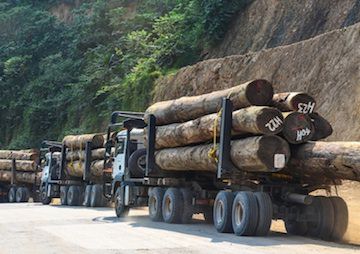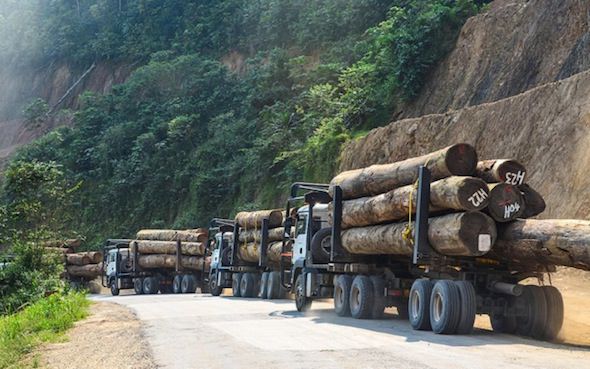Loss of Rainforests Is Double Whammy Threat to Climate
New research spells out the devastating impacts that complete destruction of tropical forests would have on global temperatures, weather patterns and agriculture.
By Tim Radford, Climate News Network

A convoy of trucks carrying logs from tropical forests in Gabon, central Africa. Photo by jbdodane via Flickr
This piece first appeared at Climate News Network.
LONDON — Tropical rainforests do more than just soak up carbon dioxide and renew atmospheric oxygen, they affect the weather in the rest of the world as well. And if the Amazon rainforest disappeared, the US Midwest could begin to dry up during the growing season.
In what is claimed as the most comprehensive analysis to date, US researchers report in Nature Climate Change that they used climate models to test the consequences of the complete devastation of the tropical rainforests.
They found that wholesale felling and clearing of the forests in Amazonia, Africa and South-east Asia would have consequences that extended far beyond the tropics, and could affect agriculture in North America, Europe and Asia.
“Tropical deforestation delivers a double whammy to the climate — and to farmers,” says Deborah Lawrence, an environmental scientist at the University of Virginia.
Rainfall patterns
“Most people know that climate change is a dangerous global problem, and that it’s caused by pumping carbon into the atmosphere. But it turns out that removing forests alters moisture and air flow, leading to changes — from fluctuating rainfall patterns to rises in temperatures — that are just as hazardous, and happen right away.
“The impacts go beyond the tropics — the UK and Hawaii could see an increase in rainfall, while the US Midwest and Southern France could see a decline.”
Although the research is based on computer simulations, there is already evidence that the disappearance of the tropical forests has begun to affect regional climates. The dry season in Thailand has become drier, and the rainy season in the Amazon has been delayed by up to two weeks, in those tracts that have been cleared. In the forested regions, the rains still arrive on time.
The tropical forests are under assault everywhere. Were they to disappear altogether, then planetary temperatures — soaring in any case because of climate change — would rise by an additional 0.7°C. This would double the warming observed since 1850.
“We’re talking about conditions that are very different from anything humanity has ever experienced.”
So the moist, dense green cover that once screened vast areas of the equatorial belt is — like the oceans and the ice caps — a vital part of the climate machine.
Without the forests, the tropics would be significantly hotter. Because dense foliage turns ground water back into water vapour, it cools the air above it. Without the forests, temperatures would soar and large masses of air would start to rise as far as the stratosphere and start to ripple away to disturb weather patterns in the temperate zones.
The complete loss of tree cover in the Amazon basin — and a huge proportion has already disappeared — would reduce rainfall in parts of the US Midwest and Northwest and in the Southern states.
Were the Africa rainforests to vanish, there would be lower levels of rainfall in the Gulf of Mexico, in the Ukraine, and in Southern Europe. On the other hand, the Arabian Peninsula might benefit.
“In the last few centuries, the average global temperature has never varied by more than about one degree,” Professor Lawrence says. “Once we go above one degree — to 1.5 degrees or more — we’re talking about conditions that are very different from anything humanity has ever experienced.
“Farmers, so reliant on consistent and reliable growing conditions, could lose their bearings, and even their incomes, when facing these ups and downs in temperature and rainfall. While farmers may ultimately adapt to shifts in the season, it’s difficult, if not impossible, for farmers to adapt to increased floods or parched soils.”
Range of species
Studies such as these have their own uncertainties. However, the vital role of the rainforests as moderators of climate, as shelters for an extraordinary range of species, and as arbiters of the global water supply has been well established.
And as much tropical forest has already being cleared for cattle ranching and commercial agriculture, scientists have decades of data to work with.
The study found that the total loss of forests would also have direct local impacts, and people who cleared the forests for immediate gain would lose in the long run.
Without the forests in West Africa or the Congo, rainfall would drop by 40% or more, and temperatures would rise by 3°C. In the Amazon, if 40% of the forest was cleared, wet season rainfall would be reduced by 12% and dry season rainfall by 21%.
Your support matters…Independent journalism is under threat and overshadowed by heavily funded mainstream media.
You can help level the playing field. Become a member.
Your tax-deductible contribution keeps us digging beneath the headlines to give you thought-provoking, investigative reporting and analysis that unearths what's really happening- without compromise.
Give today to support our courageous, independent journalists.






You need to be a supporter to comment.
There are currently no responses to this article.
Be the first to respond.